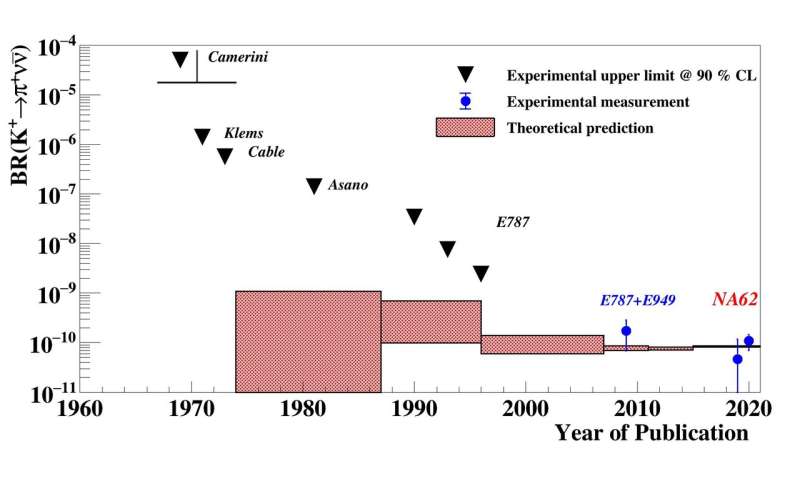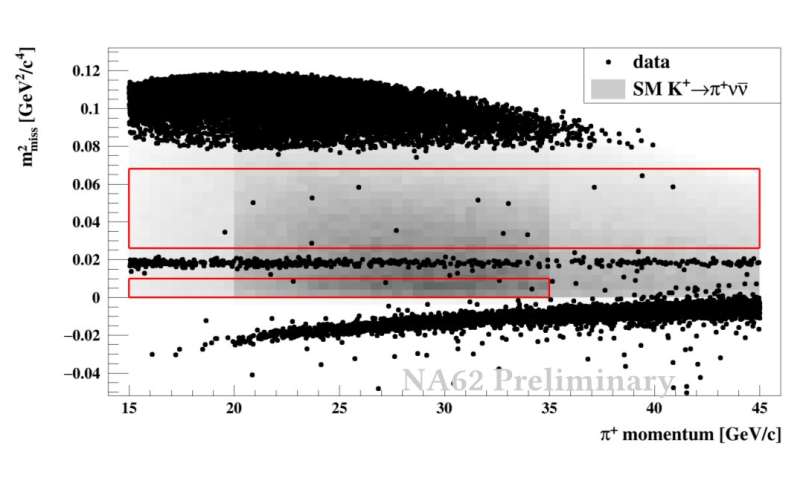Scientists at CERN have reported on their first significant evidence for a process predicted by theory, paving the way for searches for evidence of new physics in particle processes that could explain dark matter and other mysteries of the universe.Today the CERN NA62 collaboration, which is part-funded by the UK's Science and Technology Facilities Council (STFC) and involves a number of UK scientists, presented at the ICHEP 2020 conference in Prague the first significant experimental evidence for the ultra-rare decay of the charged kaon into a charged pion and two neutrinos, (i.e. K+ → π+νν).
The decay process is important in cutting-edge physics research because it is so sensitive to deviations from theoretical predictions. This means that it is one of the most interesting things to observe for physicists looking for evidence to supports alternative theoretical model in particle physics.
Professor Mark Thomson, particle physicist and Executive Chair of STFC, said that this was exciting progress because the result shows how precise measurements of this process could lead to new physics, beyond the Standard Model of particle physics developed in the 1970s:
"The Standard Model describes the fundamental forces and building blocks of the universe. It is a highly successful theory, but there are several mysteries of the universe that the Standard Model does not explain, such as the nature of dark matter and the origins of the matter–antimatter imbalance in the universe.
"Physicists have been searching for theoretical extensions to the Standard Model. Measurements of ultra-rare processes provide an exciting avenue for exploring these possibilities, with the hope of discovering new physics beyond the Standard Model."
The UK participants in this research are from the Universities of Birmingham, Bristol, Glasgow and Lancaster, and have been funded by STFC which is part of UK Research and Innovation, as well as by the Royal Society and the European Research Council (ERC).

The NA62 experiment has been designed and constructed, with a significant UK contribution, specifically for measurement of these ultra-rare kaon decays, from kaons produced by a unique high-intensity proton beam provided by the CERN accelerator complex. The kaons are created by colliding high-energy protons from CERN's Super Proton Synchrotron (SPS) into a stationary beryllium target. This creates a beam of secondary particles which contains and propagates almost one billion particles per second, about 6% of which are kaons. The main aim of NA62 is to measure precisely how the charged kaon particle decays into a pion and a neutrino–antineutrino pair. The UK has a strong leading role in the K+ → π+νν decay analysis."This kaon decay process is called the 'golden channel' because of the combination of being both ultra-rare and excellently predicted in the Standard Model. It is very difficult to capture and holds real promise for scientists searching for new physics," explains Professor Cristina Lazzeroni, Particle Physicist at the University of Birmingham, and spokesperson for NA62.
"This is the first time we have been able to obtain significant experimental evidence for this decay process. It is an exciting moment because it is a fundamental step towards capturing the precise measurement of the decay and identifying possible deviations from the Standard Model.
"In turn, this will enable us to find new ways of understanding our universe. The instruments and techniques developed in the NA62 experiment will lead to the next generation of rare kaon decays experiments."
The new result measured to a 30% precision, gives the most precise measurement to date of this process. The result is consistent with the Standard Model expectation, but still leaves room for the existence of new particles.
More data is needed to reach a definitive conclusion on the presence or not of new physics.
STFC Ernest Rutherford Fellow Dr. Giuseppe Ruggiero from Lancaster University has been the leading analyst for this measurement since 2016, and helped to create the experiment. He said:

"Analysing the data from the experiment posed a real challenge. We had to suppress a huge amount of unwanted data, by about one thousand billion times. And we had to do this without losing the tiny signal that we wanted to detect. This is much more challenging that finding a needle in a million haystacks! We used a method called blind analysis technique. So called, because the analysis is done without looking in the region, or "blind box", where the signal is supposed to be."
STFC also funded two Ernest Rutherford Fellowships, one at the University of Liverpool and then Lancaster, and one at the University of Birmingham. In addition, three doctoral students at the University of Birmingham received support from STFC and one is now working as a postdoctoral researcher on the project. All five 'early-career' physicists have worked on the project.
The data used in the research was taken between 2016–2018 at the CERN's Prevessin site, in France, and the research involves over 200 scientists from 31 institutions. A new period of data taking will start in 2021 and will allow the NA62 collaboration to put a more definite answer on the question of new physics.
The findings
The new result comes from a detailed analysis of the complete NA62 data set collected so far, corresponding to exposure of 6×1012 kaon decays. Because the process being measured is so rare, the team had to be particularly careful not to do anything that might bias the result. For that reason, the experiment was carried out as a 'blind analysis', where physicists initially only look at the background to check that their understanding of the various sources is correct.
Only once they are satisfied with that, they look at the region of the data where the signal is expected to be; this is called "blind analysis". Following a blind analysis, seventeen K+ → π+νν candidates are observed in the main dataset collected in 2018, revealing a significant excess over the expected background of only 5.3 events.
This excess leads to the first evidence for this process (with a statistical significance above the "three sigma" level). The decay rate, measured to a 30% precision, gives the most precise measurement to date of this process. The result is consistent with the Standard Model expectation, but still leaves room for new physics effects. More data are needed to reach a definitive conclusion on the presence or not of new physics.
The probability for this process to happen, called "branching ratio", for the ultra-rare K+ → π+νν decay is very small and predicted within Standard Model of particle physics to a high precision: (8.4±1.0)×10-11. This leads to exceptional sensitivity to the possible phenomena beyond the Standard Model description, making this decay a "golden mode", i.e. one of the most interesting observables at the precision frontier of particle physics. The experimental study is however extremely challenging due to the tiny rate, a neutrino pair in the final state, and huge potential background processes. Due to its characteristics, the NA62 experiment has excellent sensitivity to a variety of rare kaon decays and exotic processes.
The NA62 collaboration is preparing to collect an even larger dataset in 2021–24, when the CERN SPS will restart operation, taking data at a higher beam intensity with an improved beam line and detector setup. The next target is a "five sigma" observation of the K+ → π+νν decay, followed by a measurement of the decay rate to a 10% precision, thereby providing a powerful independent test the Standard Model of particle physics. The horizon of a new physics programme with a sensitivity to decay rates well below the 10-11 level is now in sight.
For the longer term future, a high-intensity kaon beam programme is starting to take shape, with prospects to measure the K+ → π+νν decay to a few % precision, to address the analogous decay of the neutral kaon, KL → π0νν, and to reach extreme sensitivities to a large variety of rare kaon decays which are complimentary to investigations in the beauty quark sector.



No comments:
Post a Comment